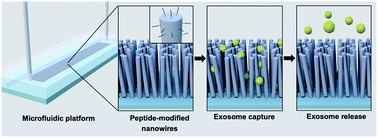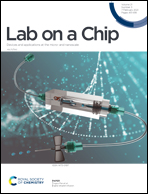Microfluidic-based capture and release of cancer-derived exosomes via peptide–nanowire hybrid interface†
Abstract
Cancer-derived circulating exosomes or nanoscale extracellular vesicles are emerging biomarkers for disease detection and treatment because of their cell-specific constituents and unique intercellular pathways. For efficient exosome isolation from bio-fluids, the design of high-affinity nanointerfaces is of great importance in the development of miniaturized systems for the collection of exosomes. Herein, we report peptide-functionalized nanowires as a biorecognition interface for the capture and release of cancer-derived exosomes within a microfluidic channel. Based on the amino-acid sequence of EWI-2 protein, a partial peptide that bound to the CD9 exosome marker and thus targeted cancer exosomes was screened. Linkage of the exosome-targeting peptide with a ZnO-binding sequence allowed one-step and reagent-free peptide modification of the ZnO nanowire array. As a result of peptide functionalization, the exosome-capturing ability of ZnO nanowires was significantly improved. Furthermore, the captured exosomes could be subsequently released from the nanowires under a neutral salt condition for downstream applications. This engineered surface that enhances the nanowires' efficiency in selective and controllable collection of cancer-derived exosomes provides an alternative foundation for developing microfluidic platforms for exosome-based diagnostics and therapeutics.



 Please wait while we load your content...
Please wait while we load your content...
